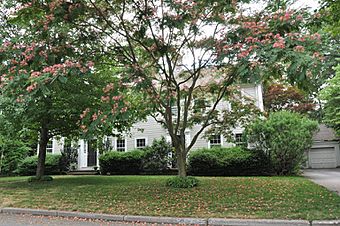Bartlett–Hawkes Farm facts for kids
Quick facts for kids |
|
|
Bartlett–Hawkes Farm
|
|
 |
|
| Location | 15 Winnetaska Road, Waban Newton, Massachusetts |
|---|---|
| Area | less than one acre |
| Built | 1736 |
| Architectural style | Federal |
| MPS | Newton MRA |
| NRHP reference No. | 86001770 |
| Added to NRHP | September 4, 1986 |
The Bartlett–Hawkes Farm is a very old house located at 15 Winnetaska Road in the Waban village of Newton, Massachusetts. It's special because its oldest part was built around 1736, making it the oldest building still standing in Waban.
Over the years, the house was made bigger several times. It was even moved to its current spot in 1915! This historic home was added to the National Register of Historic Places on September 4, 1986, which means it's recognized as an important historical site.
Contents
What Does the Bartlett–Hawkes Farm Look Like?
The Bartlett–Hawkes Farm is in a neighborhood west of Waban village. It's a wooden house with two and a half stories. It has a roof that slopes down on the sides and is covered with wooden boards called clapboard.
Unique Saltbox Shape
The back of the house has a special roof design. It extends all the way down to the first floor, making the house look like a saltbox. This was a common style for homes built a long time ago.
Front Entrances
On the front of the house, there are two main doors. Each door is decorated in a style called Federal period. This means they have columns (pilasters) and a fancy top part (corniced entablature). The door on the left also has tall, narrow windows next to it.
Who Lived at the Bartlett–Hawkes Farm?
The oldest part of the house, which is the southernmost three sections, was built around 1736. It was first owned by Ebenezer Bartlett. He had a large farm of about 100 acres (40 hectares) and raised seventeen children in this house with his wife, Anne.
Growing the Farm and Family
As the family grew, so did the house! It was expanded to five sections. Ebenezer's son, Elisha, made the farm even bigger, reaching about 200 acres (80 hectares). Elisha also served in the local army during the American Revolutionary War.
New Owners and Changes
Later, Elisha's son, Peregrine, sold the farm to another local farmer named George Hawkes in the mid-1800s. In the early 1900s, new owners added more sections to the north side of the house and built the saltbox-style back part. The house used to face Beacon Street, but in 1915, it was carefully moved about 200 feet (60 meters) to where it stands today.



